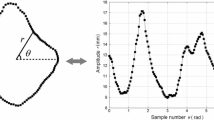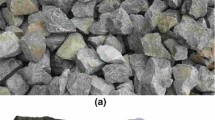Abstract
Ballast particles are an important part of the railway ballast bed. Ballast particles with irregular shapes and strong randomness are not only of significance for ensuring track stability, but also provide good elasticity to absorb the impact and vibration of wheel–rail interaction. However, it is obviously unrealistic to import the contour of every real ballast particle when using the discrete element method (DEM) simulation. Therefore, this paper developed a new algorithm, the random midpoint displacement method (RMDM), for the fast reconstruction and random generation of 2D ballast particle contour. Seven morphological parameters are proposed to describe the surface characteristics of ballast particles based on the analysis of the contour samples of three typical ballast particles using MATLAB. This method was verified by comparison with the real ballast particle based on particle morphology analysis and DEM simulation. The results show that the reconstructed ballast contour by RMDM is consistent with the field ballast contours in the view of the fractal dimensions and has an improvement in the view of the computational efficiency.















Similar content being viewed by others
References
Ouhbi N, Voivret C, Perrin G, Roux J-N (2016) Railway ballast: grain shape characterization to study its influence on the mechanical behaviour. Proc Eng 143:1120–1127
Gong J, Nie Z, Zhu Y, Liang Z, Wang X (2019) Exploring the effects of particle shape and content of fines on the shear behavior of sand-fines mixtures via the DEM. Comput Geotech 106:161–176
Tafesse S, Fernlund JMR, Bergholm F (2012) Digital sieving-Matlab based 3-D image analysis. Eng Geol 137–138:74–84
CEN (2013) Aggregates for railway ballast, Britain.
Cundall PA, Strack ODL (1979) A discrete numerical mode for granular assemblies. Géotechnique 29:47–65
Feng YT, Owen DRJ (2014) Discrete element modelling of large scale particle systems—I: exact scaling laws. Comput Particle Mech 1(2):159–168
Nakashima H, Fujii H, Oida A, Momozu M, Kanamori H, Aoki S, Yokoyama T, Shimizu H, Miyasaka J, Ohdoi K (2010) Discrete element method analysis of single wheel performance for a small lunar rover on sloped terrain. J Terrramech 47:307–321
Xiao H, Zhang ZH, Cui XH, Jin F (2021) Experimental study and discrete element analysis of ballast bed with various sand content. Constr Build Mater 271:121869
Zhang ZH, Xiao H, Wang M, Zhang MY, Wang JQ (2021) Research on dynamic mechanical behavior of ballast bed in windblown sand railway based on dimensional analysis. Constr Build Mater 287:123052
Mirghasemi AA, Rothenburg L, Matyas EL (2002) Influence of particle shape on engineering properties of assemblies of two-dimensional polygon-shaped particles. Géotechnique 3:209–217
Lu M, McDowell MR (2009) The importance of modelling ballast particle shape in the discrete element method. Granular Matter 9:69–80.
Guo Y, Markine V, Song J, Jing G (2018) Ballast degradation: effect of particle size and shape using Los Angeles Abrasion test and image analysis. Constr Build Mater 169:414–424
Anochie-Boateng JK, Komba JJ, Mvelase GM (2013) Three-dimensional laser scanning technique to quantify aggregate and ballast shape properties. Constr Build Mater 43:389–398
Katagiri J, Matsushima T, Yamada Y (2010) Simple shear simulation of 3D irregularly-shaped particles by image-based DEM. Granular Matter 12:491–497
Ferellec J, McDowell G (2010) Modelling realistic shape and particle inertia in DEM. Géotechnique 60:227–232
Bian X, Li W, Qian Y, Tutumluer E (2019) Micromechanical particle interactions in railway ballast through DEM simulations of direct shear tests. Int J Geomech 19:1–19
Huang H, Tutumluer E (2013) Image-aided element shape generation method in discrete-element modeling for railroad ballast. J Mater Civ Eng 26:527–535
Guo Y, Markine V, Zhang X, Qiang W, Jing G (2019) Image analysis for morphology, rheology and degradation study of railway ballast: a review. Transportation Geotechnics 18:173–211
Tahmasebi P (2018) Packing of discrete and irregular particles. Comput Geotech 100:52–61
Tahmasebi P (2019) An optimization-based approach for modeling of complex particles. Powder Technol 356:342–352
Zhang X, Tahmasebi P (2022) Coupling irregular particles and fluid: complex dynamics of granular flows. Comput Geotech 143:104624
Zhang X, Tahmasebi P (2022) Investigation of particle shape and ambient fluid on sandpiles using a coupled micro-geomechanical model. Powder Technol 409:117711
Bowman ET, Soga K, Drummond TW (2000) Particle shape characterisation using Fourier analysis. University of Cambridge, England
Wettimuny R, Penumadu D (2004) Application of Fourier analysis to digital imaging for particle shape analysis. J Comput Civ Eng 18:2–9
Mollon G, Zhao J (2014) 3D generation of realistic granular samples based on random fields theory and Fourier shape descriptors. Comput Methods Appl Mech Eng 279:46–65
Zhou B, Wang J, Wang H (2018) Three-dimensional sphericity, roundness and fractal dimension of sand particles. Géotechnique 68:18–30
Tahmasebi P, Sahimi M (2018) A stochastic multiscale algorithm for modeling complex granular materials. Granular Matter 20:1–19
Liu JX, Xiao JL, Liu H, Liu GZ, Wang P, Lin YK (2019) Random generation method of ballast 2D topology based on particle characteristics. Constr Build Mater 221:762–771
Souza DOC, Menegalli FC (2011) Image analysis: statistical study of particle size distribution and shape characterization. Powder Technol 214(1):57–63
Jilesen J, Kuo J, Lien F-S (2012) Three-dimensional midpoint displacement algorithm for the generation of fractal porous media. Comput Geosci 46:164–173
Huang S, Li XX (2010) Improved random midpoint-displacement method for natural terrain simulation. In: Third international conference on information and computing, pp 255–258
Sala N, Metzeltin S, Sala M (2002) Applications of mathematics in the real world Territory and landscape, University of Italian Switzerland, pp326–333.
Hentschel ML, Page NW (2003) Selection of descriptors for particle shape characterization. Part Part Syst Charact 20:25–28
Guida G, Viggiani GMB, Casini F (2019) Multi-scale morphological descriptors from the fractal analysis of particle contour. Acta Geotech 15:1067–1080
Xiao JH, Zhang D, Wei K, Luo Z (2017) Shakedown behaviors of railway ballast under cyclic loading. Constr Build Mater 155:1206–1214
Indraratna B, Thakur PK, Vinod JS (2009) Experimental and numerical study of railway ballast behavior under cyclic loading. Int J Geomech 88:61–73
Wang B, Martin U, Rapp S (2017) Discrete element modeling of the single-particle crushing test for ballast stones. Comput Geotech 88:61–73
Koohmishi M, Palassi M (2016) Evaluation of the strength of railway ballast using point load test for various size fractions and particle shapes. Rock Mech Rock Eng 49:2655–2664
Zhao LH, Zhang SH, Huang DL, Wang X (2020) A digitalized 2D particle database for statistical shape analysis and discrete modeling of rock aggregate. Constr Build Mater 247:1–19
Lian Heng Z, Dong Liang H, Han Cheng D, Shuai Hao Z, De Jian L (2017) Reconstruction of granular railway ballast based on inverse discrete Fourier transform method. Granular Matter 19:1–17.
Zhu H, Ji CC (2011) Fractal theory and its applications. China Science Publishing & Media Ltd, Beijing
Barnsley MF (1986) Fractal functions and interpolation. Constr Approx 2:303–329
Wang HN, Bu Y, Wang YZ, Yang X, You ZP (2016) The effect of morphological characteristic of coarse aggregates measured with fractal dimension on asphalt mixture’s high-temperature performance. Adv Mater Sci Eng 2016:1–9
Kiinkenberg B (1994) A review of methods used to determine the fractal dimension of linear features. Math Geol 26:23–46
Tutumluer E, Huang H, Hashash Y, Ghaboussi J (2006) Aggregate Shape Effects on Ballast Tamping and Railroad Track Lateral Stability, AREMA 2006 Annual Conference, Louisville.
Nadimi S, Ghanbarzadeh A, Neville A, Ghadiri M (2020) Effect of particle roughness on the bulk deformation using coupled boundary element and discrete element methods. Comput Particle Mech 7(3):603–613
Yan Y, Di SC, Su Y, Ji SY (2012) Discrete element analysis of elastic modulus of railway ballasts in wind with different sand contents. Chin J Comput Mech 29:439–446
Acknowledgements
The authors gratefully acknowledge the project support extended by the Fundamental Research Funds for the Central Universities (Grant No. 2018YJS117) and the National Natural Science Foundation of China (Grant No. 51978045).
Author information
Authors and Affiliations
Corresponding author
Ethics declarations
Conflict of interest
The authors declare that they have no known competing financial interests or personal relationships that could have appeared to influence the work reported in this paper.
Additional information
Publisher's Note
Springer Nature remains neutral with regard to jurisdictional claims in published maps and institutional affiliations.
Rights and permissions
Springer Nature or its licensor (e.g. a society or other partner) holds exclusive rights to this article under a publishing agreement with the author(s) or other rightsholder(s); author self-archiving of the accepted manuscript version of this article is solely governed by the terms of such publishing agreement and applicable law.
About this article
Cite this article
Wang, Y., Xiao, H., Ling, X. et al. 2D ballast particle contour generation based on the random midpoint displacement algorithm. Comp. Part. Mech. 10, 729–745 (2023). https://doi.org/10.1007/s40571-022-00526-1
Received:
Revised:
Accepted:
Published:
Issue Date:
DOI: https://doi.org/10.1007/s40571-022-00526-1




